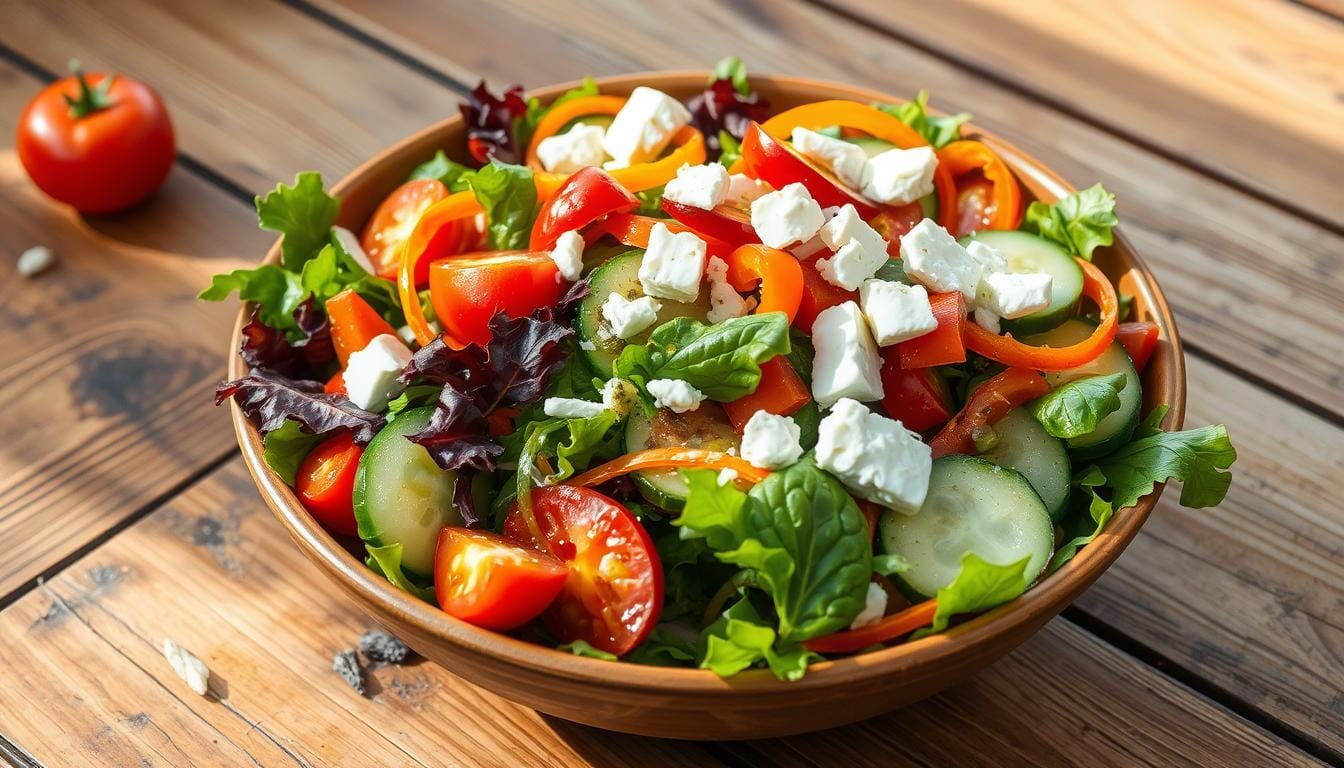Discover the Perfect Mixed Salad for Any Occasion
Every summer evening, I remember watching my grandmother make a vibrant mixed salad. It could instantly brighten our family dinners. Those memories sparked my passion for creating healthy salads.
A delicious mixed salad is more than just tossing ingredients together. It’s an art form that balances flavors, textures, and nutrition. Whether it’s for a quick lunch or an elegant dinner party appetizer, a fresh salad can make any meal special.
In this guide, you’ll learn how to make the perfect mixed salad for every occasion. We’ll cover ingredient selection, preparation techniques, and creative combinations. Get ready to turn simple greens into spectacular dishes that will impress family and friends.
From crisp vegetables to protein-rich toppings, a well-crafted mixed salad offers endless possibilities. Your journey to salad mastery starts right here. You’ll learn techniques to make restaurant-quality salads in your own kitchen.
Table of Contents
Essential Guide to Mixed Salad Fundamentals
Starting a mixed green salad is all about the basics. You need to pick the right ingredients and learn some key techniques. This will help you make a salad that’s both tasty and healthy.
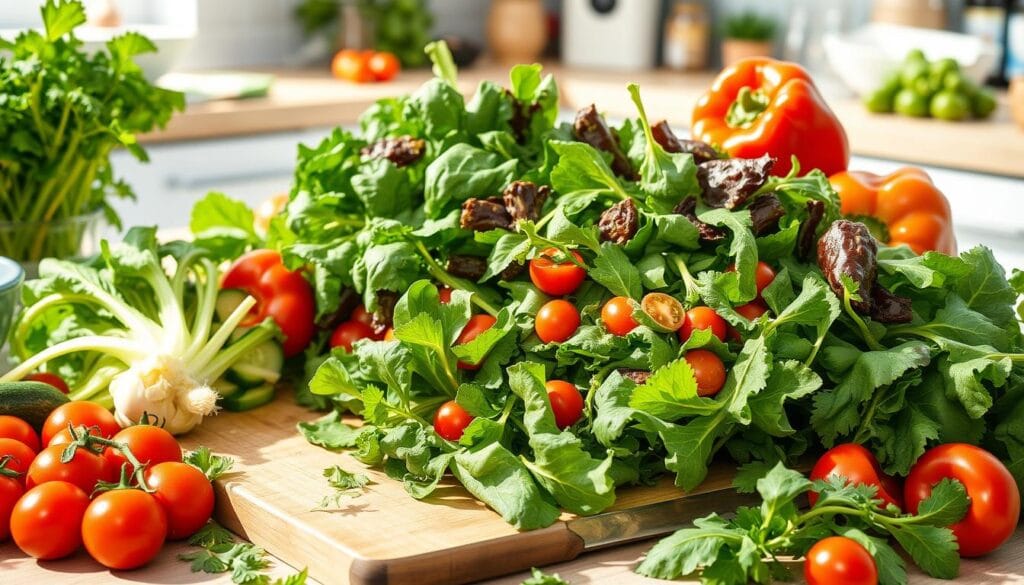
Making a great mixed green salad takes focus and a love for fresh ingredients. The base and the quality of the ingredients are key to a fantastic salad.
Understanding Salad Bases
Choosing the right salad base is important. Different greens can change your salad from good to amazing. They add unique flavors and textures.
- Romaine: Crisp and sturdy, perfect for hearty salads
- Arugula: Peppery and bold, adds a distinctive flavor
- Baby Spinach: Tender and nutrient-dense
- Green and Red Leaf Lettuce: Soft and delicate
Choosing the Right Greens
When picking greens, look for fresh, bright leaves. Organic options are ideal, but washing conventionally grown greens well works too.
“The secret to a great salad is using the freshest greens possible.” – Culinary Expert
Proper Salad Preparation
| Preparation Step | Key Details |
|---|---|
| Washing | Use cool water, gently rinse leaves |
| Drying | Use salad spinner or pat dry with clean towel |
| Storage | Keep in sealed container with paper towel |
Good salad prep means better flavor and freshness. A salad spinner helps get your greens crisp and dry. This makes them perfect for holding dressing.
The art of making a mixed green salad is about mixing flavors, textures, and freshness. Take your time, try different mixes, and enjoy making your perfect salad.
The Art of Mixed Salad Composition
Making a balanced salad is more than just mixing ingredients. It’s about choosing and combining them wisely. This way, you get the best taste and health benefits.
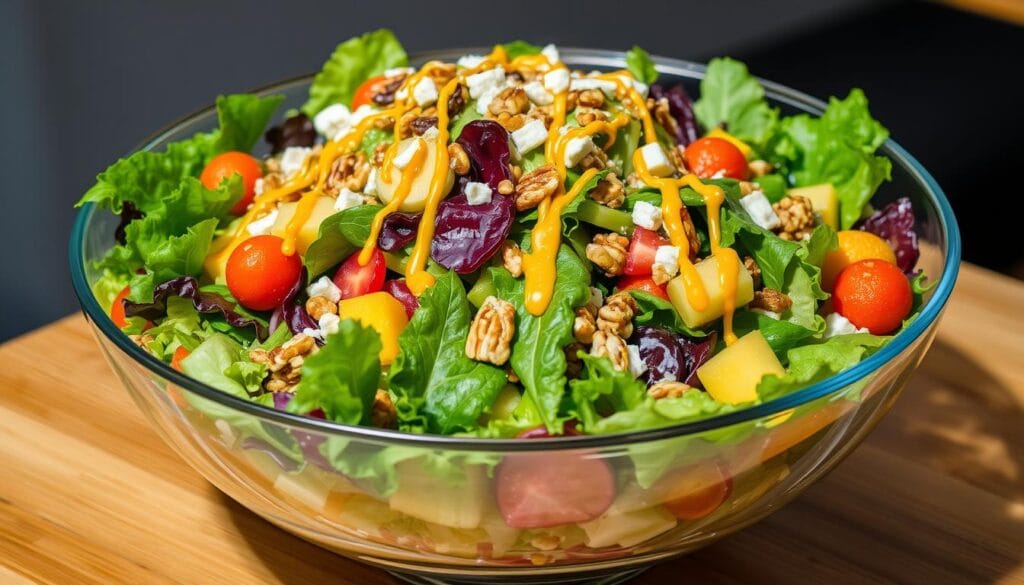
- Balance flavors across different taste profiles
- Create textural variety
- Include colorful and nutrient-dense components
- Mix raw and cooked ingredients
“A great salad is a symphony of tastes, textures, and colors.” – Professional Chef
Your salad should have many parts that work well together. Mix crisp greens like baby romaine and spinach with protein like garbanzo beans or avocado. Add crunch with sunflower seeds and brightness with cherry tomatoes.
Nutrition experts suggest:
- 1-2 types of leafy greens
- 1-2 protein sources
- 2-3 vegetable varieties
- 1 crunchy topping
- Optional fruit element
Try out different mixes to find your favorite salad. Remember, variety makes meals fun and healthy.
Fresh Ingredients Selection and Seasonal Variations
Making a fresh salad starts with picking the right seasonal ingredients. The quality of your salad can turn a simple dish into a memorable one. Learning how to choose and mix ingredients will make your salad stand out.
Peak Season Vegetables
Each season brings its own chance to make vibrant salads. Choose vegetables that are in season to get the best taste and health benefits.
- Spring: Tender asparagus, radishes, spring onions
- Summer: Juicy tomatoes, crisp cucumbers, colorful bell peppers
- Fall: Roasted squash, hearty kale, sweet root vegetables
- Winter: Robust greens, winter citrus, pickled vegetables
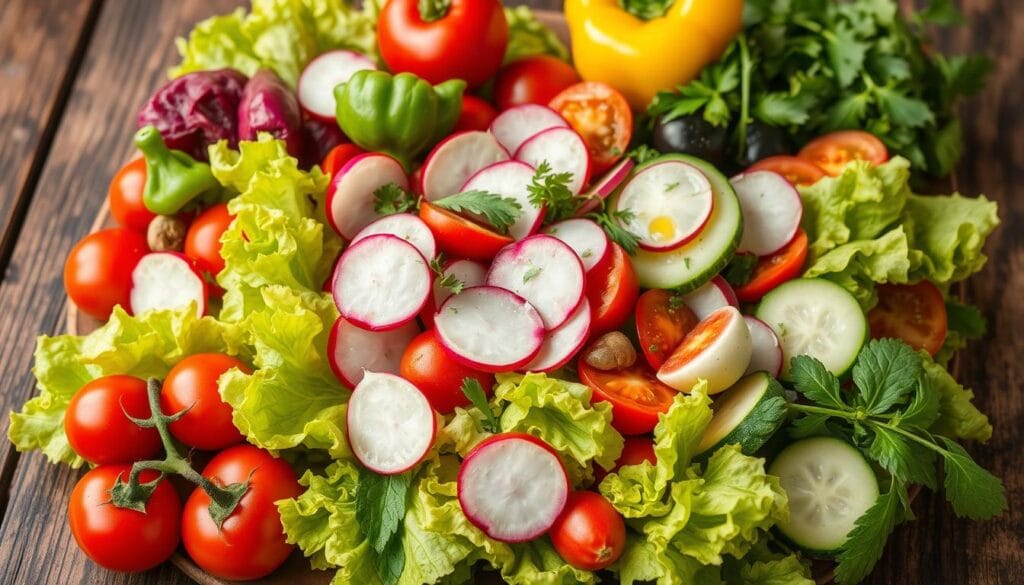
Fruit Integration Tips
Fruits can add a burst of flavor and interest to your salad. Try these tasty pairings:
- Berries with peppery arugula
- Citrus segments with bitter greens
- Sliced apples with spinach
- Pomegranate seeds with winter salad mixes
Herb Selection Guide
Fresh herbs are key to amazing salads. They add depth of flavor that makes your salad unforgettable.
| Herb | Flavor Profile | Best Paired With |
|---|---|---|
| Basil | Sweet, peppery | Tomatoes, mozzarella |
| Cilantro | Bright, citrusy | Avocado, citrus fruits |
| Mint | Cool, refreshing | Cucumber, berries |
“The best salads are a celebration of seasonal ingredients, carefully selected and lovingly prepared.” – Culinary Expert
By using fresh, seasonal ingredients and trying new combinations, you’ll make salads that are both healthy and delicious.
Protein Options for Hearty Mixed Salads
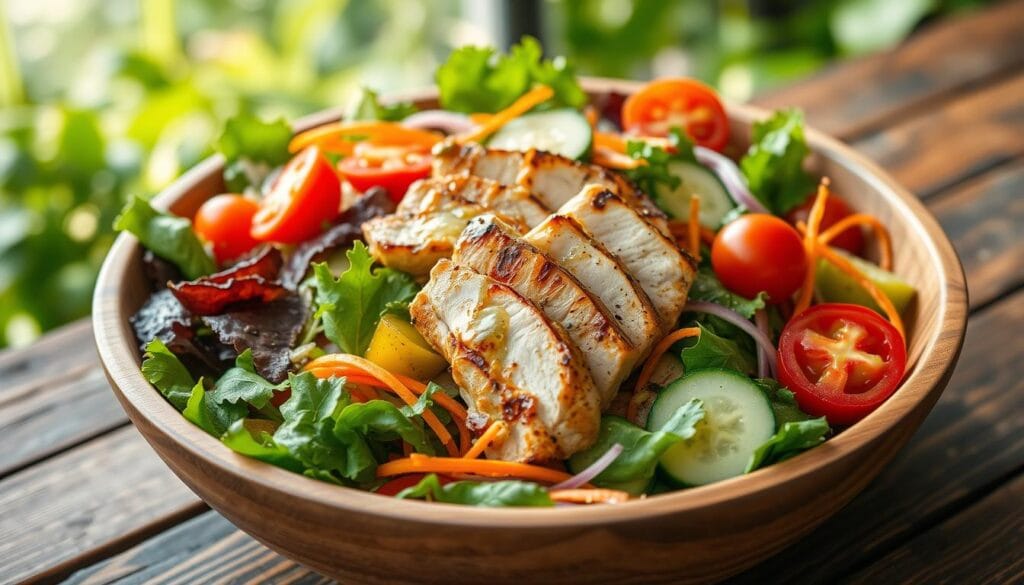
Make your protein salad a main dish by choosing the right protein. A salad with chicken can have 49 grams of protein, great for those watching their diet.
Here are some protein-rich options to make your salad better:
- Grilled chicken: Offers 38 grams of protein per cup
- Shrimp: Provides approximately 20 grams in 12 pieces
- Hard-boiled eggs: Contributes 6 grams per egg
- Tuna: Contains around 40 grams per cup
For those who don’t eat meat, here are some great alternatives:
- Crispy tofu
- Tempeh
- Edamame
- Chickpeas
- White beans
“A well-crafted salad with chicken can be both delicious and nutritionally complete” – Culinary Nutrition Expert
Here are some tips for making your protein salad:
- Pre-prep ingredients in separate containers
- Experiment with different protein sources
- Customize ingredient quantities
- Focus on flavor-enhancing dressings
| Protein Source | Protein Content | Serving Size |
|---|---|---|
| Grilled Chicken | 38g | 1 cup |
| Tuna | 40g | 1 cup |
| Shrimp | 20g | 12 pieces |
| Hard-boiled Egg | 6g | 1 egg |
Pro tip: The right protein can turn a simple salad into a nutritious, filling meal that satisfies your hunger and supports your health goals.
Creative Texture Combinations and Toppings
Turning your salad into something special is all about texture and flavor. The right mix can make your meal a feast for the senses.
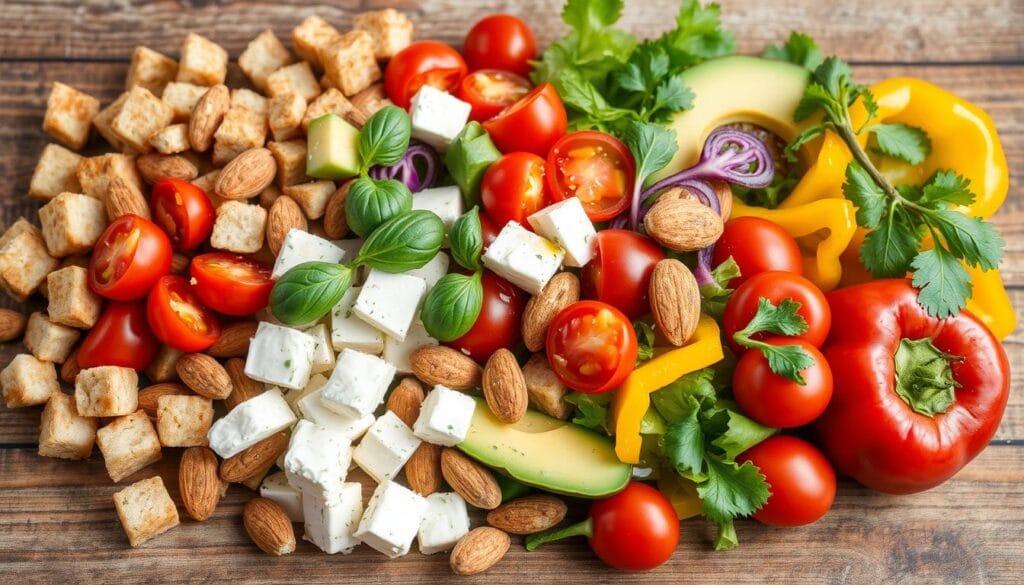
To make a crunchy salad, pick your ingredients wisely. It’s about mixing different textures to keep each bite exciting.
Crunchy Elements That Elevate Salad Texture
Add fun crunch to your salads with these toppings:
- Toasted nuts like almonds and walnuts
- Roasted seeds such as pepitas and sunflower seeds
- Crispy tortilla strips
- Homemade croutons
- Roasted chickpeas
Creamy Components for Smooth Contrast
Pair your crunchy bits with these creamy ones:
- Ripe avocado chunks
- Soft goat cheese
- Creamy hummus dollops
- Greek yogurt-based dressings
Flavor Enhancers for Depth and Excitement
Boost your salad’s flavor with these ingredients:
- Marinated red onions
- Briny olives
- Sun-dried tomatoes
- Fresh herb sprinkles
“A great salad is a symphony of textures and flavors, where every ingredient plays a critical role.” – Culinary Expert
The goal is to create a salad that excites all your senses. Try different mixes to find your favorite salad.
Mastering Homemade Salad Dressings
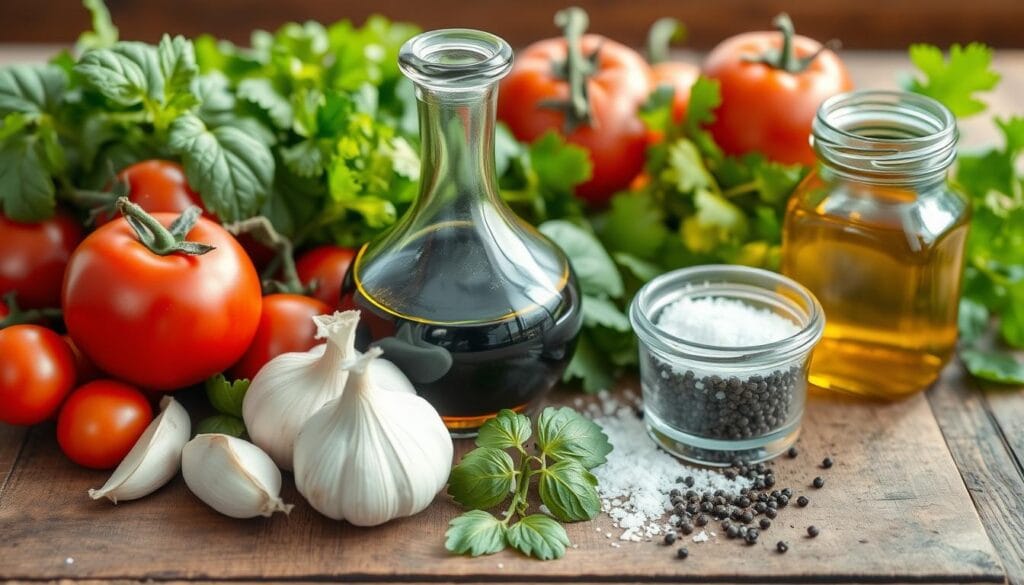
Making your own salad dressing can turn a simple salad into a work of art. It only takes five minutes to make a tasty vinaigrette that’s healthier than store-bought ones.
“The best salad dressing is the one you make yourself, with fresh ingredients and love.”
A basic homemade salad dressing recipe is easy. It mixes three parts olive oil with one part vinegar or citrus. This simple mix lets you get creative and make it your own.
Essential Ingredients for Homemade Dressings
- Extra virgin olive oil
- Apple cider vinegar or champagne vinegar
- Fresh herbs
- Salt and pepper
Here are some tips for making your salad dressing:
- Soak diced shallots in vinegar for 10 minutes to mellow their flavor
- Try different vinegars for unique tastes
- Use mustard to mix ingredients smoothly
Versatile Dressing Applications
| Dressing Type | Best Used On | Storage Time |
|---|---|---|
| Classic Vinaigrette | Mixed greens, romaine, arugula | Up to 2 weeks |
| Creamy Herb Dressing | Kale salads, grain bowls | 5-7 days |
| Citrus Vinaigrette | Grilled vegetables, quinoa | Up to 1 week |
Your homemade salad dressing can be Whole30, Keto, Paleo, Gluten-Free, and Sugar-Free. By choosing your ingredients, you avoid bad stuff in store-bought dressings.
A great homemade salad dressing is all about flavor balance and using fresh ingredients. Start simple and make your own special vinaigrette. It will make your salads unforgettable.
Mixed Salad Presentation Techniques
Creating a memorable salad is more than just taste. It’s about how it looks and the art of presentation. Chefs and home cooks know that how you plate a dish can turn it into a work of art.
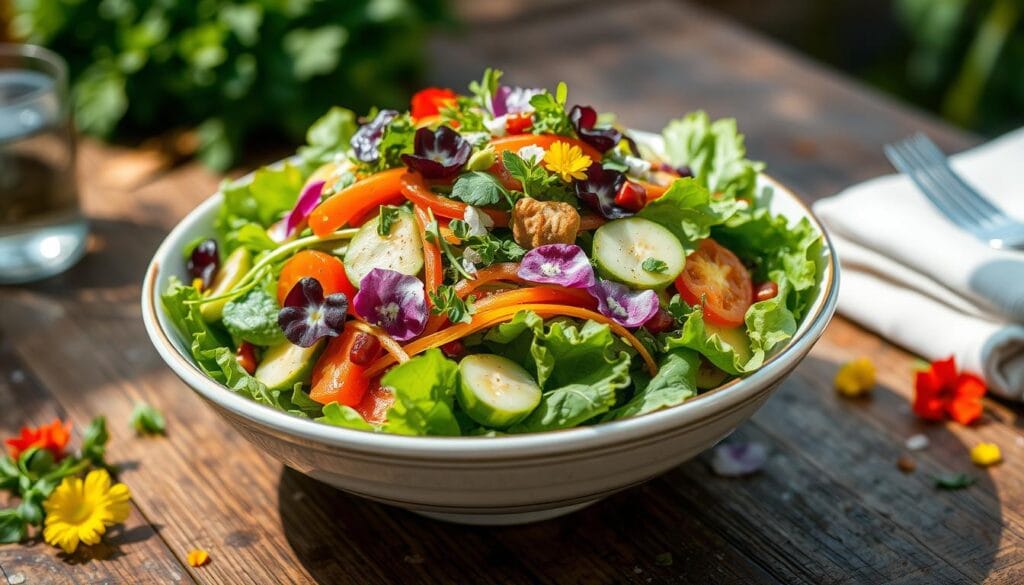
Experts with over 24 years of experience have mastered salad garnish and plating. They say that how something looks can make you want to eat it more.
Plating Strategies for Maximum Impact
- Use white plates to highlight vibrant salad colors
- Cut ingredients uniformly for clean presentation
- Create height and dimension on the plate
- Utilize negative space strategically
Color Balance Tips
Getting the colors right in your salad is key. Here’s what the experts suggest:
- Incorporate vegetables with contrasting colors
- Use herbs as natural color accents
- Balance warm and cool tones
Innovative Garnishing Methods
Take your salad to the next level with these garnishing tips:
| Garnish Type | Visual Impact | Recommended Use |
|---|---|---|
| Fresh Herbs | High | Sprinkle delicately |
| Edible Flowers | Elegant | Scatter sparingly |
| Toasted Seeds | Textural | Sprinkle generously |
“Great food presentation is about creating an experience that delights all senses.” – Culinary Expert
By using these salad presentation tips, you can make simple ingredients look amazing. Your dishes will impress both your eyes and taste buds.
Nutritional Benefits and Dietary Considerations

Making a healthy salad is more than just mixing greens. It’s about creating a dish full of nutrients that boost your health. Darker greens like kale, spinach, and romaine are packed with vitamins and minerals.
You can tailor your salad to fit your dietary needs. Here are some tips to make your salad healthier:
- Choose greens with lots of antioxidants
- Add protein for fullness
- Use colorful veggies for more nutrients
- Include healthy fats for better vitamin absorption
Protein is key to turning a simple salad into a satisfying meal. Try adding grilled chicken, canned salmon, hard-boiled eggs, or legumes.
“Not all salads are created equal – the key is strategic ingredient selection” – Nutrition Experts
Watch out for unhealthy additions. Dressings and toppings like cheese, croutons, and bacon can add too many calories. Choose olive oil-based dressings and use them in moderation.
| Green Type | Calories per Cup | Key Nutrients |
|---|---|---|
| Romaine | 8 | Vitamin A, K, Folate |
| Spinach | 7 | Iron, Calcium, Vitamin C |
| Kale | 10 | Antioxidants, Vitamin K |
Knowing these tips can turn your salad into a strategic part of a balanced diet.
Special Occasion Mixed Salad Ideas
Take your party salad to the next level with creative recipes. These can turn any gathering into a memorable event. Whether it’s a holiday or an elegant dinner, the right salad can be the highlight.
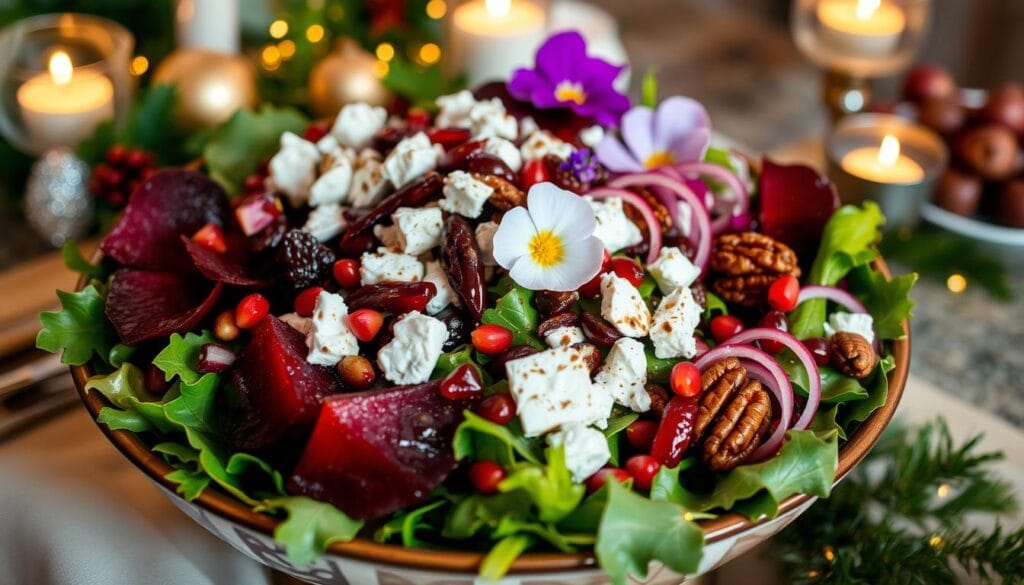
For summer parties, try these holiday salad ideas. They mix fresh ingredients with beautiful presentation:
- Watermelon and Feta Salad: A refreshing summer party salad
- Pomegranate and Candied Nut Winter Salad: Perfect for holiday events
- Seared Scallop Gourmet Salad: An elegant dinner party centerpiece
Seasonal ingredients make your salad festive. Winter needs hearty salads with roasted veggies and grains. Summer calls for light, crisp mixes.
“A great salad is like a work of art – it should delight both the eyes and the palate.”
For special occasion salads, presentation is key. Here are some styling tips:
- Use white plates to make colors pop
- Create height with layered ingredients
- Garnish with edible flowers or micro-herbs
Your gourmet salad can make any event unforgettable. It’s a culinary experience guests will talk about for a long time.
Conclusion
Mixed salad tips open up a world of creativity in your kitchen. Your salad journey is just starting. You can make amazing meals with simple ingredients.
Versatile salads are more than healthy food; they’re a way to express yourself. You can add super seeds or try new veggies. Each salad shows off your taste and health goals.
Making the perfect salad is like art. It’s about mixing nutrition, flavor, and what you like. Start with good ingredients, try different textures, and be bold. Your skills will grow with each salad, making it a fun and healthy meal.
Learning these tips shows that mixed salads are more than sides. They’re full meals that boost your energy and health. Start your salad adventure and see greens in a new light.

